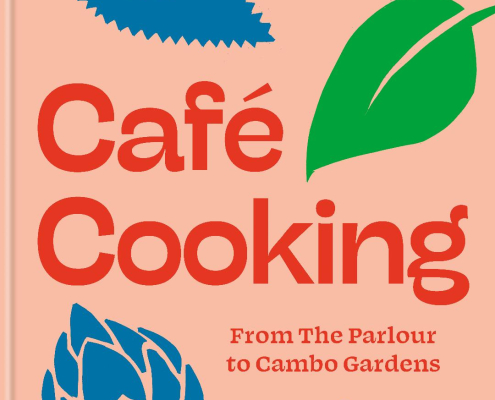Kitchen Press is a new, independent publisher specialising in food writing. It aims, through lovingly crafted bespoke cookbooks, to connect innovative chefs, expert food writers and independent restauranteurs with customers and others around the world who love food.
We believe that the whole experience of reading about food and cooking should be as pleasurable and inspiring as eating it, and we want to help promote the people and places doing that best.


Coming soon…. The Greenwich Market Cookbook!
Half of the market is given over to street food traders, selling food from all over the globe. The smells! The sights! The foods you’ve never even heard of and really had better try out! There is Madagascan coconut chicken. There is Ethiopian injera. There are wonderful, silky but robust La-mian (noodles) in amber broth. There are cakes galore: vegan cakes, gluten-free cakes, sugar-free cakes, full fat and full dairy cakes. It’s been a real pleasure to work with the traders on the book – and a real learning experience too. It’s such a global community that the recipes cover food from all over the world – from ramen burgers to ravioli, bánh mì to burritos. Now I know what they do with pounded cassava leaf in Madagascar – and very soon, so will you.
The market is owned and run by Greenwich Hospital, an ancient Crown charity providing charitable support including annuities, sheltered housing and education to serving and retired personnel of the Royal Navy and Royal Marines and their dependents. Greenwich Hospital have great vision for the market, and 2015 saw a raft of major improvements being implemented – a new glass roof, relaid cobblestones and a brand new pavilion that will host the all the street food traders. The market has remained open throughout, but traders and punters alike will be delighted when the works are completely finished in March this year.
Next time you have a spare day in London, I can wholeheartedly recommend getting the river boat up the Thames and having a wander around the parks of Greenwich, leaving plenty of time for a market lunch.
The Greenwich Market Cookbook comes out in March 2016. Pre-order here!
Sarah Savoy’s Sweet Potato Pie
Sweet Potato Pie
I can’t imagine how Mom ever got me to try a pie made from a potato, sweet or not. I probably thought it was pumpkin because I’m sure I wouldn’t have tried this as a kid if I knew what it was. I now prefer it to pumpkin. It’s another one of those cool-weather pies, spicy and creamy and absolutely comforting.
Preheat the oven to 170°C (325°F).
Peel the sweet potatoes and cut into chunks, then boil them until tender. Drain, and leave to cool a moment.
In a large bowl, mash the sweet potato with a fork or potato masher. Using a hand mixer, add the butter and process until it’s fully incorporated. Stir in the sugar, milk, eggs, nutmeg, cinnamon, allspice and vanilla extract and mix until you have a smooth batter.
Roll out the pastry and line a 23cm pie dish. Trim and crimp the edges, and make some holes in the base with a fork. Pour in the filling.
Bake the pie for 50–60 minutes or until a knife inserted in the centre comes out clean. The pie will rise as it bakes, but it will settle again as it cools.
Serve at room temperature or chilled.
Serves 8
All photographs © Joby Catto
Buy The Savoy Kitchen – A Family History of Cajun Food here
La-Mian: A Noodle Story
Lamian dough – heftier to work than it looks.
It’s been incredibly exciting seeing the recipes coming in from traders for the Greenwich Market Cookbook, everything from Arapina‘s wonderful Greek biscuits and pastries, delicate & fragrant & redolent with her family’s history in Asia Minor, to Pig Dogs & Brisket’s deep and dirty southern-style mac & cheese. But as well as being an inspiration, the global nature of the market has also brought along some difficulties.The La-Mian and Dim Sum stall is a quiet legend in street food circles – they used to work from Brick Lane but are now permanent fixtures in Greenwich – and from the moment the project started, I knew we had to get them on board. Lui Zhongyi and his wife Kelly make a wonderful array of food, but they are most famous for the hand-pulled noodles which Zhongyi pulls and stretches with a theatrical zeal quite at odds with his serious persona. Of course, he’s not really dour at all – he just isn’t so comfortable with the English language and as it was his culinary secrets we were after for the book, this was a problem. Enter the amazing Jessie Levene! Jessie is a polyglot, and a greedy one at that (I mean that as a compliment). Having spent 3 years in China, writing a column on regional foods and blogging about her experiences, she not only speaks great Mandarin but also has a real wealth of knowledge about the context of different Chinese dishes. So, thanks to Jessie we will have some of Zhongyi & Kelly’s domestic recipes in the book, but in the meantime she has also very generously given us some background about la-mian in general and some of her wonderful photos of noodle pullers in action in China. Here they is, because the second best thing to eating la-mian is reading about them:
La-mian (literally translated into English as ‘Pulled Noodles’) are a truly visual eating experience – fresh wheat dough pulled by hand into long, even strands, served in a plain beef broth. Perhaps this doesn’t sound all that special, but it must be seen to be believed, and in China, La-mian are usually made within eyesight of the diners. Through a magical and mind-boggling process of twisting, folding, pulling and loud slapping of the dough onto the work-board, the chef creates perfect noodles from raw dough in mere minutes. He or she also makes it look ridiculously easy, which it certainly is not.
La-mian comes from the city of Lanzhou, the capital of Gansu Province, in China’s north west region. Lanzhou is on the borderlands of Han China, meaning that it’s population is a lot more ethnically diverse than in the major cities on the east coast. One of the largest ethnic groups here is the Hui Muslim minority, and it is most often Hui chefs who one can find making La-mian across China. La-mian restaurants in China are usually pretty basic affairs, but are often open later than many other eating places, making them particularly convenient for a midnight snack. They’re also amongst the few restaurants in China where pork is not on the menu – Hui Muslims keep halal, and choice of meat at La-mian joints is usually only beef, chicken or lamb.
La-mian itself is a cheap, filling and delicious meal. The finished dish itself isn’t that much of a looker – just plain white noodles in a clear soup, topped with sliced cooked beef and fresh coriander. But it’s the visual spectacle of the making of the noodles, right in front of you, which makes La-mian so special.
Man pulls noodles!
Check out Jessie’s blog recounting her adventures around the world at http://jessielevene.com/.